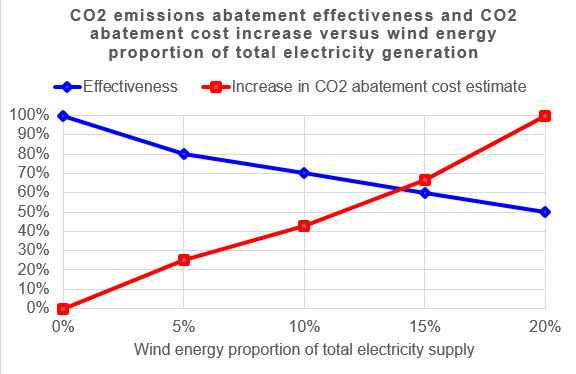I was invited to testify to the 'Senate Select Committee on wind turbines' in Canberra on 19 May 2015. Here I explain the main messages I wanted to get across in my testimony.
The cost of CO2 emissions abatement with wind turbines is much higher than current estimates (such as in the Warburton RET Review).
The cost of CO2 abatement with wind power in Australia in 2020, under the RET as currently legislated, is likely to be (refer to costs in Table 1):
Advertisement
- 2 to 5 times the carbon price which was rejected by voters at the 2013 election
- 4 to 8 times the Direct Action average price at the first auction
- 6 to 12 times the current EU ETS price
- 100 to 200 times the international carbon price futures to 2020
The Warburton RET Review estimated the cost of abatement under the LRET at $32-$72/tonne CO2 in 2020 (Section 5.6 – Cost of abatement' – from estimates by ACIL-Allen, Frontier Economics and Deloitte).
But the actual cost is likely to be much higher because the estimates apparently do not take the CO2 abatement effectiveness into account.
Wheatley estimated wind energy in the NEM was just 78% effective at abating emissions in 2014, and would be about 70% effective if wind power's share was double.
Under the current RET legislation, wind energy would have to supply about 15% of electricity in 2020. At 15% share, wind is likely to be about 60% effective.
At 60% effective, the CO2 abatement cost would be $53-$120 per tonne CO2
Advertisement

The most important recommendation from my Submission, No. 259, is:
The CO2 abatement cost estimates in the RET Review should be re-estimated taking CO2 abatement effectiveness into account.
The purpose of this recommendation is to get policy analysts and policy makers to understand the implications of CO2 abatement effectiveness with intermittent renewable energy.
If the Department of Industry, ACIL-Allen, Deloitte or Frontier Economics re-estimate the CO2 abatement cost taking the CO2 abatement cost effectiveness (e.g. from Wheatley's analysis) into account, the estimated abatement costs will be significantly higher than in the most recent estimates.
When The Treasury, Department of Finance, Department of Industry and the responsible Ministers recognise the high cost of CO2 abatement with wind power, this could be the catalyst for change. It could be the beginning of widespread recognition that the RET is a high cost way of reducing emissions and that the costs will escalate dramatically to 2020.
These cost increases will harm Australia's international competitiveness, the economy, jobs, wages and standard of living.
Below I explain the relationship between wind energy penetration, CO2 abatement effectiveness and CO2 abatement cost.
Relationship between wind energy penetration, CO2 abatement effectiveness and CO2 abatement cost

The actual CO2 abatement cost is higher than commonly estimated. In fact, the abatement cost is inversely proportional to the proportion of electricity supplied by wind power. At 80% effective the actual abatement cost would be 25% higher than the analysts' estimates if their estimates did not take effectiveness into account. At 50% effective the actual abatement cost would be twice the estimates. The chart below illustrates the relationship between effectiveness, CO2 abatement costs increase and the proportion of electricity generated by wind (80% effective is approximately correct for Australia's National Electricity Market in 2014; effectiveness at proportions of wind energy above 5% are a rough estimate for the purpose of this explanation).
Economic analyses conducted for the 2014 Renewable Energy Target (RET) Review projected that wind power will supply about 15% of Australia's electricity by 2020 if the RET legislation remains unchanged. At 15% of electricity generated by wind, international studies of other electricity grids suggests effectiveness could be nearly as low as 50%. At that rate the CO2 abatement cost would be double the estimates (if those estimates did not take effectiveness into account).
Discuss in our Forums
See what other readers are saying about this article!
Click here to read & post comments.
30 posts so far.